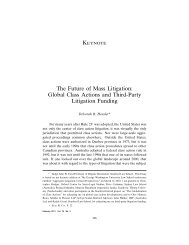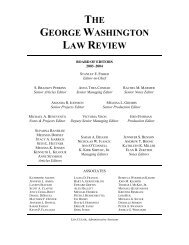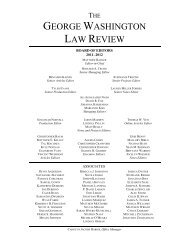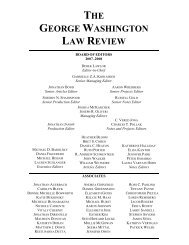View PDF - The George Washington Law Review
View PDF - The George Washington Law Review
View PDF - The George Washington Law Review
You also want an ePaper? Increase the reach of your titles
YUMPU automatically turns print PDFs into web optimized ePapers that Google loves.
2010] Oral History and the Study of the Judiciary 867<br />
Domnarski relates are anomalies and that the remainder of the judges<br />
whose histories he reviewed came from privileged backgrounds, but it<br />
is impossible to tell.<br />
<strong>The</strong> material most likely to be of value to legal scholars begins to<br />
appear in the third chapter, and from there the book relates Domnarski’s<br />
findings relating to the appointment process, the judges’ transitions<br />
to the job, and various aspects of the job of being a judge. 94<br />
Among the material that might interest researchers is that relating to<br />
the dynamics of the appointment process, 95 internal court processes, 96<br />
the effects of interpersonal conflict on court dynamics, 97 judges’ expressions<br />
of concern that increasing the size of the judiciary would<br />
dilute the prestige of the position, 98 the stress that sentencing places<br />
on judges, 99 judges’ differing perceptions of the appropriate length of<br />
opinions and when it is appropriate to publish them, 100 and trial<br />
judges’ varying perspectives on the prospect of being reversed. 101 All<br />
of these topics arise in debates concerning the judicial process, 102 and<br />
while none of the viewpoints related are novel to those debates, let<br />
alone insights that would change the terms of the discussions, the fact<br />
that they come from judges is significant.<br />
Scattered throughout the book are the occasional perspectives<br />
that are not readily available elsewhere, or that are not as well developed<br />
elsewhere. <strong>The</strong> discussions of the nature of the transition into<br />
the judicial position, for example, include the expression of impressions<br />
that I, at least, had only heard informally. <strong>The</strong> oral histories<br />
reveal judges who struggled not only with easily anticipated consequences<br />
such as a change in income, but also with the need to master<br />
94 <strong>The</strong> chapter titles are: “Judicial Appointments Recounted” (Chapter 3); “Once Appointed,<br />
Transition to the Job” (Chapter 4); “Nature of the Job” (Chapter 5); “In Chambers, in<br />
Court, and Getting Along with Others” (Chapter 6); “Judicial Opinions” (Chapter 7); and<br />
“Judges on <strong>Law</strong>yers and Other Judges” (Chapter 8). Unfortunately, these chapters represent<br />
less than two-thirds of the book. <strong>The</strong> introduction and first two chapters occupy 82 pages, while<br />
the last six chapters take up only 135.<br />
95 Id. at 83–128.<br />
96 Id. at 169–72.<br />
97 Id. at 173–78.<br />
98 Id. at 178.<br />
99 Id. at 150–56.<br />
100 Id. at 180–83, 192–95.<br />
101 Id. at 197–203.<br />
102 For a general sense of those topics, see RUGGERO J. ALDISERT, THE JUDICIAL PROCESS<br />
(2d ed. 1996); DANIEL J. MEADOR ET AL., APPELLATE COURTS: STRUCTURES, FUNCTIONS,<br />
PROCESSES, AND PERSONNEL (2d ed. 2006); Chad M. Oldfather, Course Materials for Judging<br />
and the Judicial Process (Marquette <strong>Law</strong> Sch., Legal Studies Paper No. 08-28, 2008), available at<br />
http://papers.ssrn.com/sol3/papers.cfm?abstract_id=1297423.









